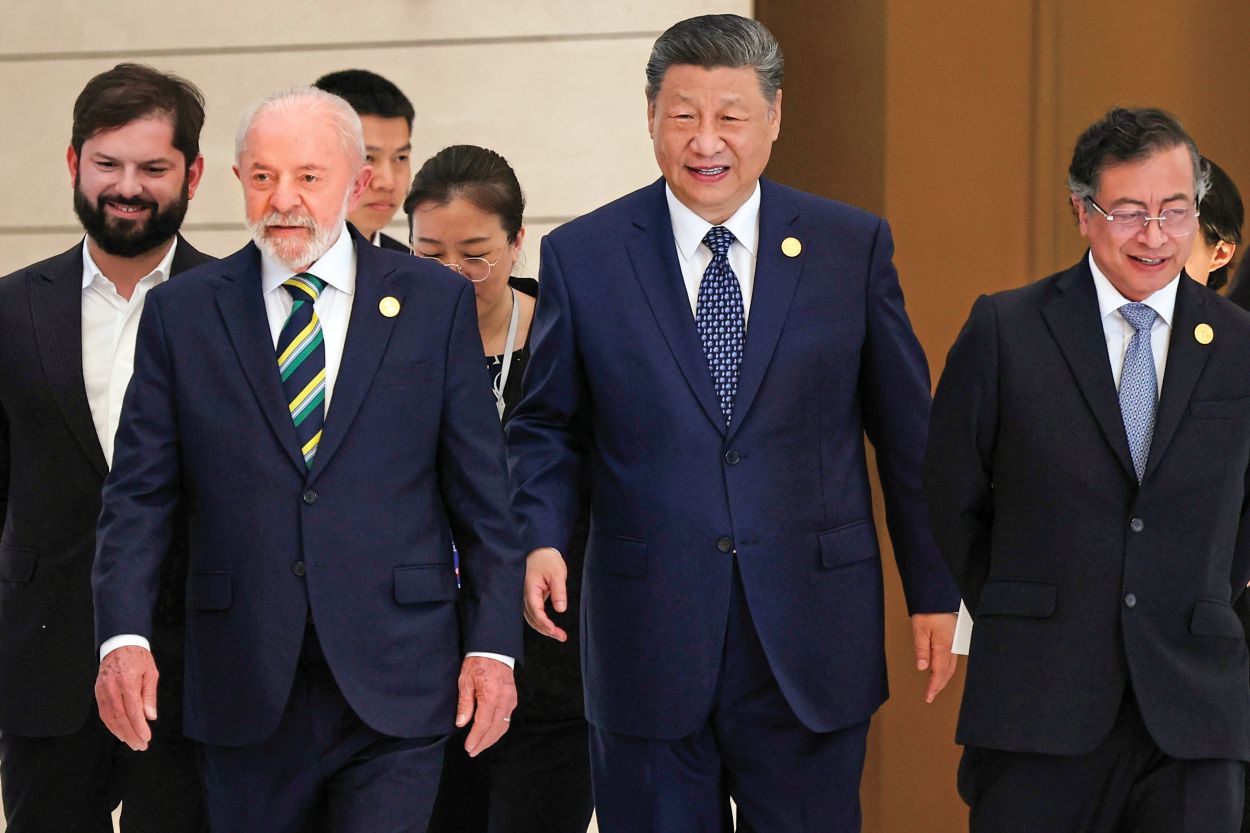Congressional Testimony: Emerging External Influences in the Western Hemisphere
Congressional Testimony: Emerging External Influences in the Western Hemisphere
"China’s entrance into the Americas has changed the game," says AS/COA Vice President Eric Farnsworth, in testimony on Beijing's rising involvement in Latin America.
HEARING BEFORE THE SENATE COMMITTEE ON FOREIGN RELATIONS
SUBCOMMITTEE ON THE WESTERN HEMISPHERE, TRANSNATIONAL CRIME, CIVILIAN SECURITY, DEMOCRACY, HUMAN RIGHTS, AND GLOBAL WOMEN'S ISSUES
MAY 10, 2017
ERIC FARNSWORTH
VICE PRESIDENT, COUNCIL OF THE AMERICAS
*** As Prepared for Delivery ***
Good morning, Chairman Rubio, Ranking Member Menendez, and Members of the Subcommittee. It is a privilege to appear before you again today. Let me also thank you, up front, for your strong, bipartisan leadership to promote hemispheric democracy and to address the worsening political, economic, and humanitarian crisis created by the Chavista regime in Venezuela.
As you know, the Council of the Americas (“Council”) is a leading policy voice on Latin America, the Caribbean, and Canada. For over 50 years, our mandate has been to promote democracy, open markets, and the rule of law throughout the Americas.
Thank you for the invitation to appear before you to discuss the very important topic of emerging external influences in the Western Hemisphere. As requested, I will address the issue of China in the Americas.
China’s Presence in the Americas is Recent but Already Well Established
Mr. Chairman and Mr. Ranking Member, let me give you the bottom line first: China’s entrance into the Americas has, in my view, been one of the most significant developments in hemispheric affairs this century. And, while other important developments such as the siren call of populist governance may be on the wane, China’s engagement is, if anything, intensifying.
China’s dramatic economic rise has necessitated new commercial and economic partners worldwide, to procure the raw materials needed to fuel China’s domestic growth while opening new markets abroad both to sell finished products and also to invest significant dollar and other international hard currency reserves. This has broad implications, particularly for the commodities producing nations of South America, which have benefited from sales to China and other developing markets. Nations such as Brazil, Chile, and Peru count China as their top trade partner; China is the second largest trade partner of Argentina, Colombia, and others. This has helped a number of nations to diversify their trade relations, proving beneficial, for example, during the global economic crisis of 2009. But because the Chinese approach to date has been overtly mercantilistic, it has also negatively impacted regional producers who now face supercharged competition in manufactured products from China, while weighting the balance toward the production of primary goods just when Latin America is looking to advance upward along the value chain.
China’s activities in Latin America on the investment side are also having an impact. In the first instance, some of the promised investment has not yet materialized, leading to unmet expectations. Still, investment is flowing and it is increasing, particularly in those commodities sectors including energy, mining, and agriculture, where China feels the need to lock in access to supplies which sustain its economy. Of particular interest is energy, where China is an active participant, most recently in the deep water of the Gulf of Mexico, but also from Argentina to Venezuela and virtually every regional energy producer in between. China is also looking to expand its regional investment portfolio with an increasing focus on infrastructure development.
All Investments Are Not Made Equal
This is not at this point a security threat per se to the United States, although it does change the competitive framework for investors and it does have broader implications for U.S. policy interests particularly as China looks to dominate industries that will increasingly form the backbone of the global economy, including artificial intelligence, cloud computing, and clean energy.
The Chinese investment model differs from others. To oversimplify, Chinese entities often pay a premium above market value for purchases, in order to lock in assets. Once an investment is confirmed, Western investment values of job creation on the local economy, technology and management transfer, corporate governance, respect for labor rights, environmental protection, anti-corruption, and corporate social responsibility are not necessarily priorities. This can unfairly put U.S. and other companies at a disadvantage by lowering the costs of Chinese production vis-à-vis the competition.
But there are larger implications, as well. Since the end of the Cold War, Latin America has worked diligently to promote democratic governance. Progress has been uneven but generally positive; it is unquestionably in the U.S. interest to support these efforts. Open market democracies that broadly share values tend to make the best long-term partners of the United States in the promotion of shared interests. China’s entry into the Americas has complicated this effort, not just in the conduct of business but also in the conduct of foreign policy.
Changing the Calculus for Policy Implementation
For example, efforts to promote labor and environmental reforms through sound business practices and formal trade agreements are undermined when nations sign agreements with China that do not include similar provisions, and Chinese businesses are not expected to operate under the same prevailing conditions. Multilateral lending agencies like the World Bank, IMF, and Inter-American Development Bank that promote financial reforms and good governance become less relevant if borrowing nations can receive funds from China or Chinese-led institutions without conditionality. China’s huge purchases of commodities and the provision of credits on favorable terms allows regional leaders the flexibility to postpone necessary economic and policy reforms consistent with open market, democratic governance, or to take actions that harm democracy itself. It also emboldens anti-American leaders to pursue policies at home and across the region contrary to U.S. interests.
The best example is Venezuela, which today is in the midst of humanitarian crisis. While it is clearly the responsibility of Hugo Chavez and the course that he and his followers including Nicolas Maduro have set, nonetheless the so-called Bolivarian Revolution has been enabled, at least until recently, by high oil prices as well as plentiful external financing from sources other than the United States and traditional international financial institutions. Financial support from China of well over $50 billion, according to some estimates, has allowed the regime to accelerate its anti-democratic, repressive course.
At the same time, China’s vision for the region is expanding. The upcoming May 14-15 Belt and Road Initiative meeting is just the latest high level diplomatic initiative that will include Latin America; at the APEC meetings last November in Lima, Peru, which I attended, China’s leader Xi Jinpeng went beyond the usual methodical courting of the region by publicly laying out a strategic approach to Latin America that, if fully realized, would position China as a new guarantor of open markets and international governance in the Asia-Pacific region. During the November visit, Xi strongly supported renewed progress toward the long-stalled Free Trade Area of the Asia Pacific, an initiative until recently subsumed by the now-shelved Trans-Pacific Partnership, he worked to build momentum toward the Beijing-led Regional Comprehensive Economic Partnership which is a roadmap for trade and economic linkage within Asia that excludes the United States, and he offered the Asian Infrastructure Investment Bank as a partner for infrastructure and other initiatives in Latin America, adding to pre-existing Brazilian membership in the BRICS Bank. In addition to his State Visit to Peru, he also declared Ecuador and Chile to be “comprehensive strategic partners” of China. Soon after, on November 24, 2016, China issued its latest Policy Paper on Latin America and the Caribbean, a serious and ambitious effort to strengthen ties with the region from trade and economic development to space cooperation to healthcare and global epidemics to global governance.
A Competitive Commercial Environment Calls for a More Strategic Approach
China’s interest in the Americas will continue to develop rapidly, as it has since the beginning of the century. And, while China’s engagement heretofore has primarily been economic and educational, such as Chinese language training through exchanges and also its regional Confucius Institutes, there are indications that political and security considerations, especially on cyber issues, are also growing in importance. This means that the United States must do a better job contending for the region. We need a more strategic approach based on the values that we hold dear and that we share with a majority of citizens across the Americas. Let me put this as succinctly as I can: the street protesters in Venezuela who seek outside support to end repression and restore democracy do not write their banners in Chinese or Russian or Persian. Protesters against the Castro regime do not fly the Chinese or Russian or Iranian flags during May Day parades. The example of the United States remains powerful for the citizens of oppressive regimes in the Americas. That is, so long as we do not forget that the promotion of our traditional values supports rather than undermines U.S. national security efforts and we work to promote them.
The United States Remains the Preferred Regional Partner
In many cases Latin Americans and others prefer the United States as a more natural partner than China, given history, economic opportunity, geography, culture, language, and values, but circumstances going forward will dictate policies and actions. As is often said, you can’t beat something with nothing. The APEC meetings in Lima clearly showed that strategic economic and political re-evaluation if not realignment is underway. China is playing a multi-dimensional game. That is even more reason why we should seek to compete on the playing field of greatest advantage to us, namely, democratic governance and meeting the common aspirations of the people of the region. And we should not be shy about speaking out on principle when required, ideally with the coordination and support of regional allies and also the Organization of American States.
Meanwhile, the United States would also do well to deepen further not alienate our economic relations with Canada and Mexico, nations that engage in common business practices with the United States and Europe, as partners in the promotion of a common agenda that share common values. More broadly, we also need to re-activate an ambitious economic partnership agenda for the hemisphere. Rethinking U.S. support for the Trans-Pacific Partnership gives us an opportunity now to re-envision a strategic initiative for the Americas, not just Asia. Initiatives would include stronger emphasis on energy and agriculture partnership, as well as the rule of law and anti-corruption. We also need to reconsider the regional paradigm that limits actions to the lowest common denominator as a means to achieve regional consensus on any issue, a paradigm that has become more of a straightjacket to U.S. policy implementation. And, we need to build on previous bi-partisan successes, including movement toward full and lasting peace in Colombia, and also a more effective approach to addressing the deep security, economic, and social concerns in Central America while maintaining security commitments to Mexico and the Caribbean.
The battle for the soul of Latin America continues. If anything, the United States is potentially better positioned than we have been for some time given recent changes in regional governance and the decreasing allure of populism. But China’s entrance into the Americas has changed the game. The United States must engage in a positive, pro-active manner to offer the region a vision for cooperation consistent with our values. A re-energized approach to the region is required.
Mr. Chairman, thank you again for the opportunity to testify before you this afternoon. I look forward to your questions.








